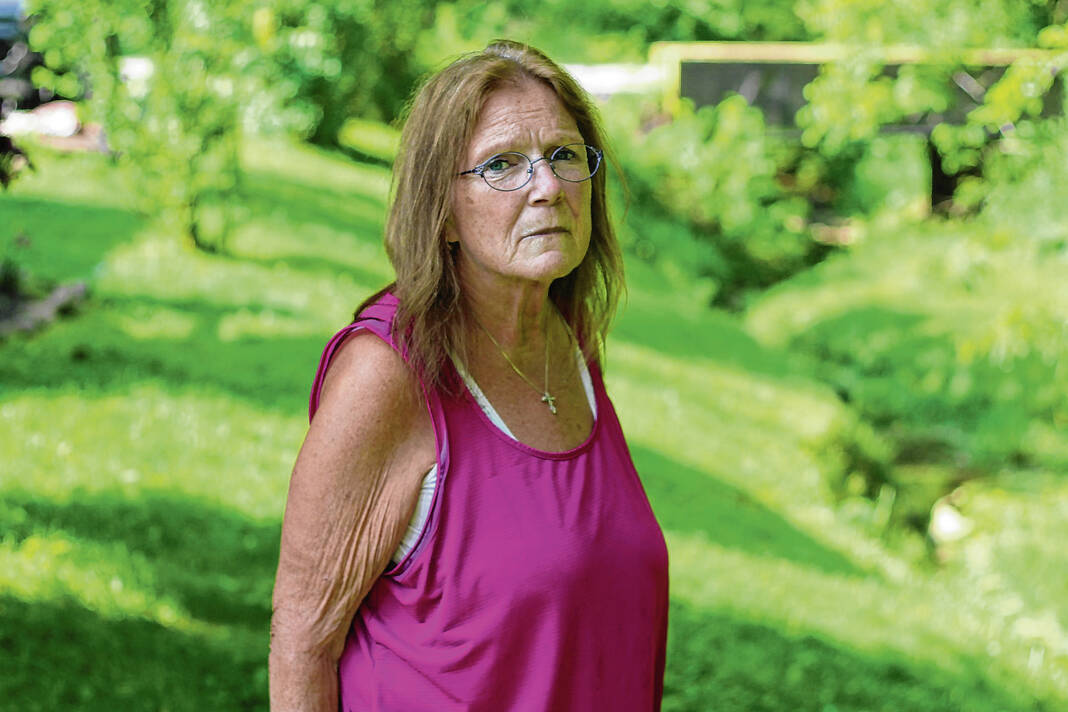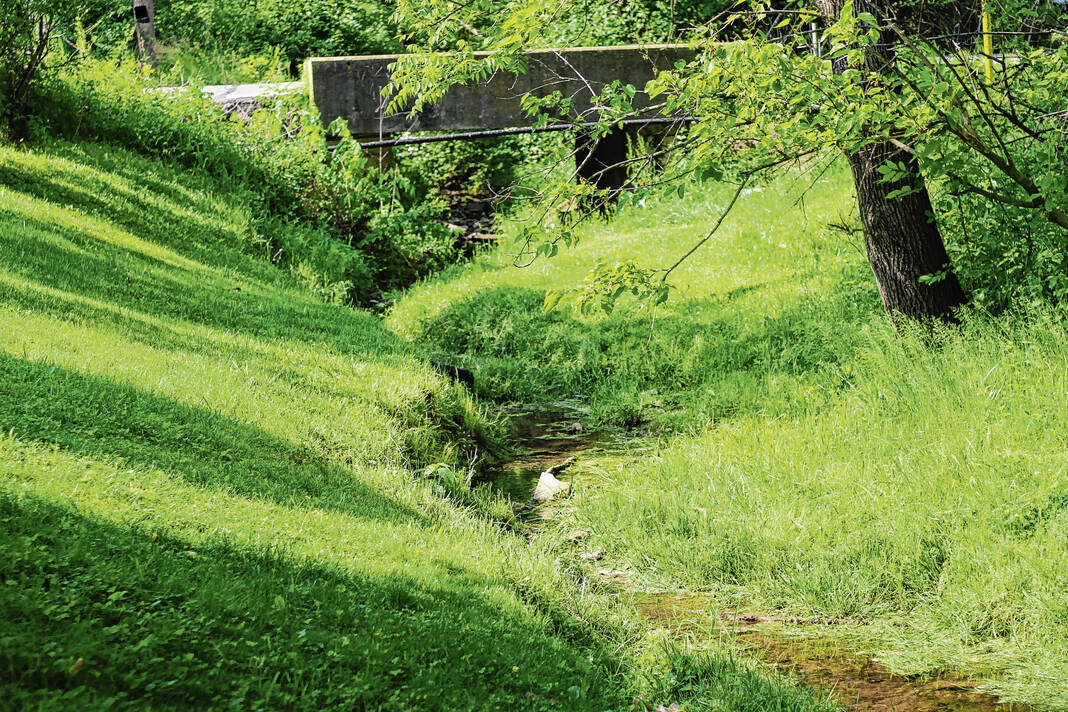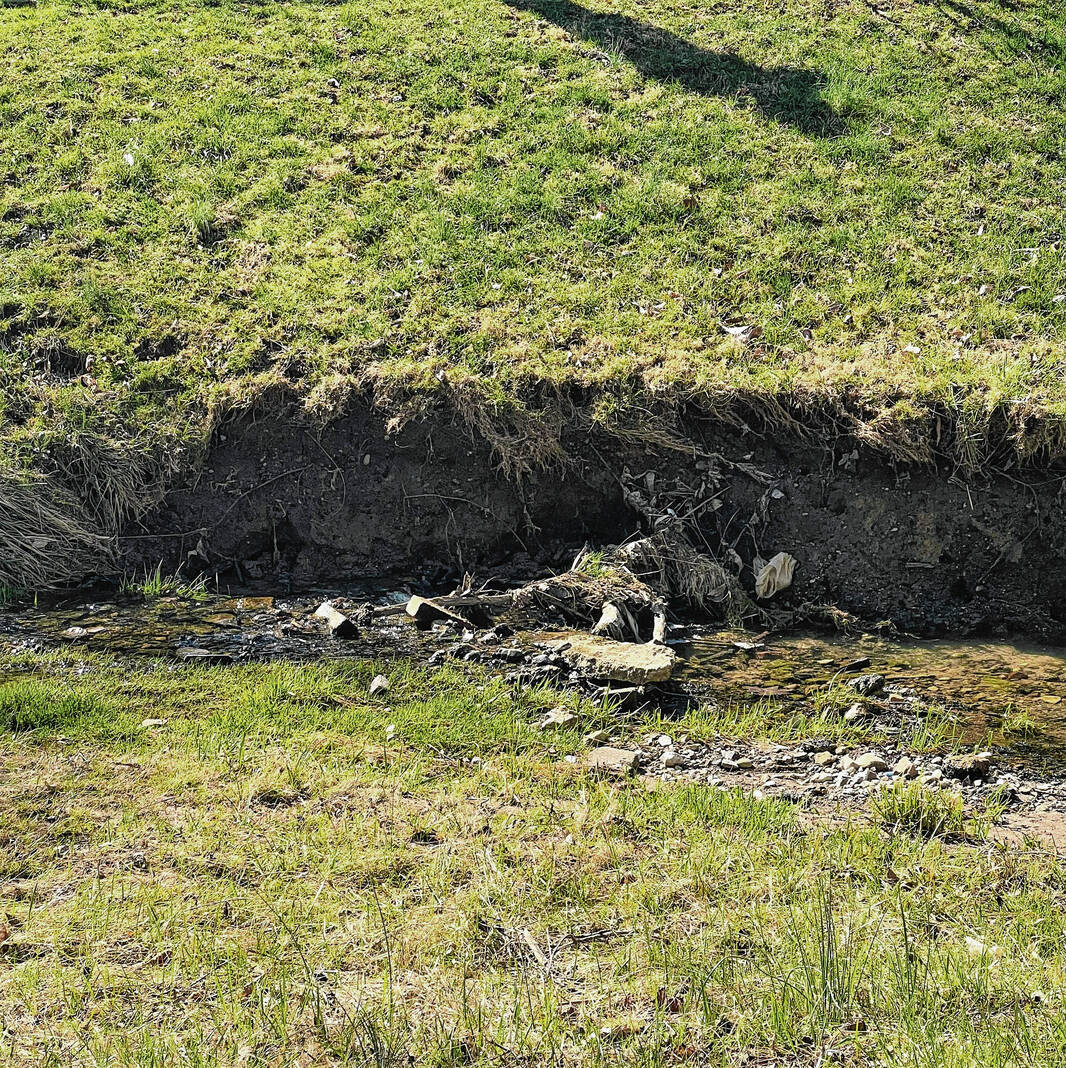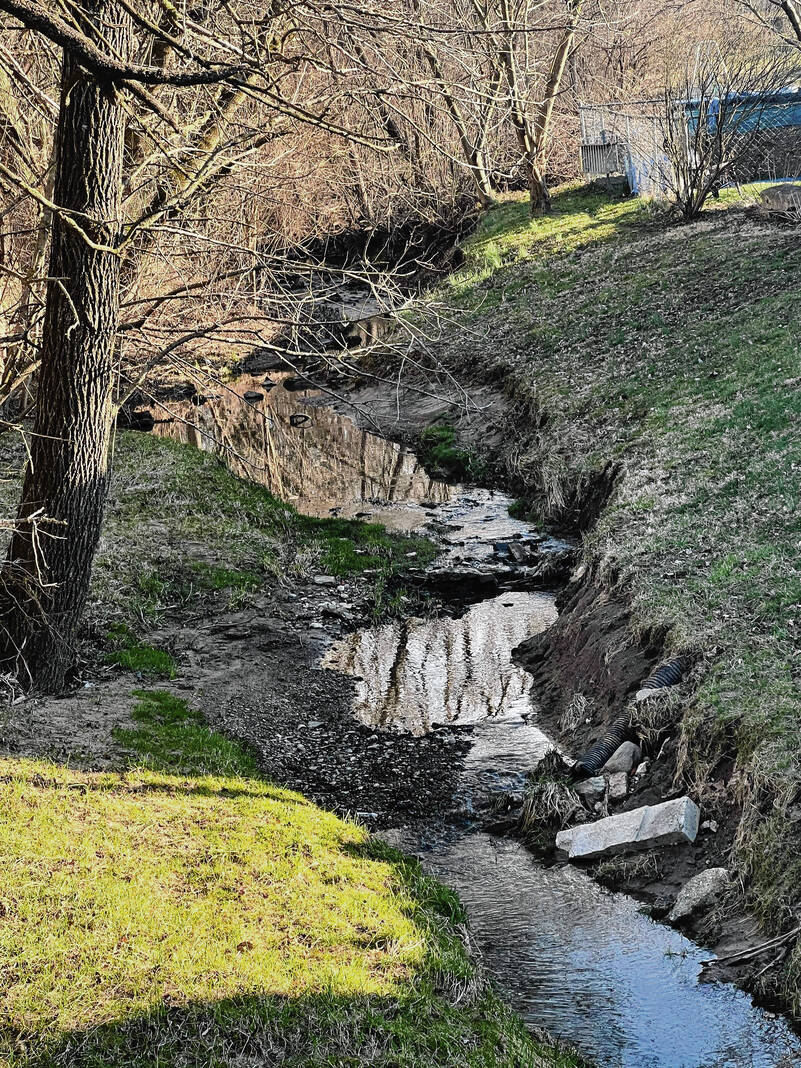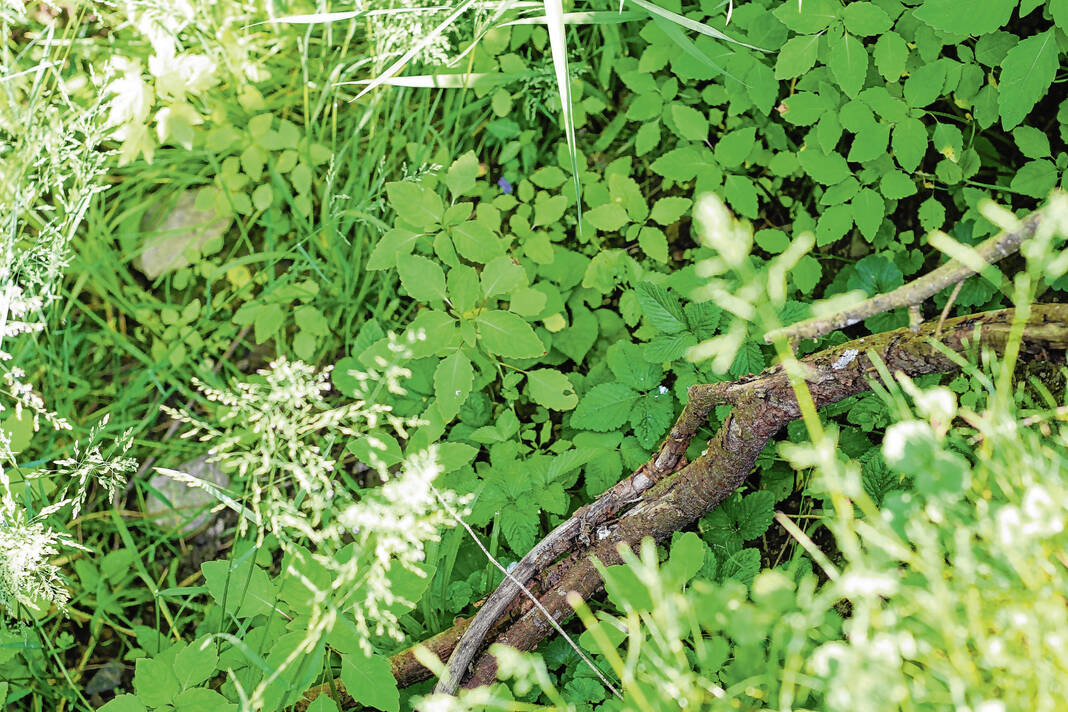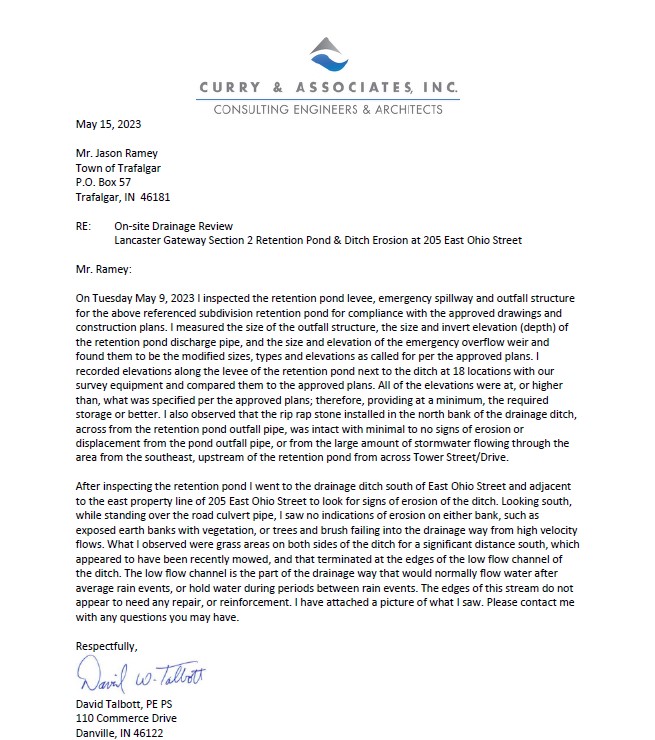
Trafalgar resident Pam Palmer stands in her yard on May 25. She’s been asking the Trafalgar Town Council for help to fix erosion in her yard for a year.
Emily Ketterer | Daily Journal
Trafalgar resident Pam Palmer feels she was led in circles by the town council after she asked them for help.
Palmer’s house on Ohio Street sits next to a small creek, which Palmer says has rapidly eroded her yard in the last two to three years. The creek has shifted to become almost 20 feet wide, with a now steep drop-off into it from her yard.
She believes the increase in the flow of water on the creek was caused by the build-out of new homes in the Lancaster Gateway subdivision on land behind her house, near the Trafalgar Public Library. Because the subdivision plans are approved by the town of Trafalgar, Palmer thought the best course of action was to ask the Trafalgar Town Council for help.
Every time there is heavy rain, water rushes through the creek, looking almost like rapids. The water level raises just a few feet from her house. Parts of her yard have started dipping off, and trees are beginning to lean from erosion, she said. One tree has exposed roots from the land movement.
In the 20 years she has lived in this house, she had never seen that much water flow through that creek, she said. Now, it’s a regular occurrence every heavy rain.
“It kept getting worse and worse until it started chunking off my yard,” Palmer said. “I used to be able to walk down that hill and step into the creek, now, it’s a steep drop-off.”
Trafalgar Town Council members had worked for the last few months to find solutions to fix Palmer’s property problems — despite some advice that it may not be the town’s problem to fix. They sent out multiple contractors and an engineer to get quotes to repair her yard to prevent further damage.
In the beginning, council members said they wanted to help Palmer and be “good neighbors.” However, the town backed out of helping Palmer earlier this month, after an engineering report said there were no signs of erosion in her yard, and that excess drainage was not coming from the Lancaster subdivision.
“I don’t understand why at one point they said they were going to do it. Then in the next point in time, they’re not,” Palmer said.
Going to the town for help
Palmer said she first reached out to the Trafalgar Town Council for help in 2016, when she noticed more water coming onto her property. She sent them a letter, but never got a response.
Lancaster Gateway was first platted in 2006 by developer Triumph Trafalgar Properties LLC, originally for 28 homes in the first section and 66 in the second section. Houses have been built over the last several years.
New sections of the neighborhood south of East Ohio Street have been under construction most recently, with building permits getting approved by the Trafalgar Planning Commission as recently as last year.
Flooding yards linked to new development is not uncommon in Trafalgar. Different yards in the Crest Ridge Estates subdivision in town started flooding or taking on more water allegedly after new houses were built. Some residents near Liberty Park also reported flooding after the town built the park and a new parking lot for it.
The drainage situation escalated for Palmer in the last two years, when the heavy rains started quickly deteriorating her yard, she said. She went to the town again in the spring of 2022. Council President Jessica Jones then helped Palmer during the spring and summer and tried to figure out the problem.
In April of last year, Jones and Palmer asked Johnson County Surveyor Gregg Cantwell to look at her property and the subdivision’s detention pond.
He visited twice, one time after a heavy rain. From his findings, he found the creek and the Stott’s Contributory, which is where stormwater from the subdivision drains into, showed signs of erosion.
“The contributory appears to be a private or mutual drain, benefiting those within its watershed, including the town of Trafalgar,” Cantwell said in an email “It is in need of maintenance, if not reconstruction, due to development and neglect of maintenance by all beneficiaries.”
Cantwell further said he had little jurisdiction in this area. He suggested Palmer hire an attorney because the problem seemed like a civil matter. He also said in an email to the Daily Journal that the ditch/creek is private, so it does not fall under municipal jurisdiction.
Who fixes it?
Who exactly holds responsibility for fixing the contributory and Palmer’s yard remains unclear. The creek next to Palmer’s house is private and the land is owned by her, and the drainage contributory is mutual or private, according to Cantwell.
After the emails from Cantwell, the topic of Palmer’s yard was not brought up again for months, as the town council focused on different problems.
Palmer returned to the council in February this year, asking for help again. There, she was met with council members who said they would try to help her. She has shown them several photos and video of the damage done to her yard.
“The whole town of Trafalgar has problems with flooding. This is literally taking my home away,” Palmer told the council.
Jones said at that meeting that the changes to Palmer’s yard within the year were evident based on photos that were from last spring and this year.
Jacob Bowman, town attorney, said from the start that the town had no obligation to help Palmer. If the issue was caused by the subdivision, the subdivision should handle it, he said in February. He also said if there is a drainage pond in need of repairs, that’s on the neighborhood’s homeowners association to fix.
The town council members at the time disagreed, and said it would be the right thing to do to try to help Palmer.
“I’m not against the attorney at all because I’m sure he’s 100% correct. But we also should try to be good neighbors,” council member Jeff Eisenmenger said in February.
In February, the council agreed to get quotes for work to regrade and riprap — which involves using rock to protect shoreline structures — to hopefully stop damage to Palmer’s yard.
In the next month, Palmer said maybe six contractors came out to her house to examine her yard and the creek. Eisenmenger also visited, she said.
By March, Eisenmenger brought two quotes to the council, estimating the cost to range from $10,000 to $32,000. The price difference was because one contractor thought it was a “bigger job” than the other, he said.
Council member Jason Ramey said he was concerned about spending money on a project that may not completely fix the issue. He suggested the town pay an engineer first to evaluate before paying a contractor to regrade and riprap.
“I don’t want to keep dragging you along, that’s not what I’m trying to do to you. But I’m also trying to save $32,000 on riprap and contractor work that might not solve the problem for you, or at least not very well or not for very long,” Ramey said in March.
The engineering report
Curry & Associates, a Danville-based engineering firm, visited Palmer’s property and the subdivision on May 9. The firm then sent a letter of its findings to the town on May 15, generally reporting they saw no issues with Palmer’s property or the subdivision drainage.
The engineer wrote in the letter that he inspected the retention pond levee, emergency spillway and outfall structure for the Lancaster Gateway retention pond for compliance with the approved drawings and construction plans.
He saw all of the elevations were at, or higher than, what was specified in the approved drainage plans, “providing at the required storage or better,” the letter reads. Rip rap stone installed in the north bank of the drainage ditch, across from the retention pond outfall pipe, was also intact with “minimal to no signs of erosion or displacement from the pond outfall pipe, or from the large amount of stormwater flowing through the area from the southeast.”
At Palmer’s property, the engineer wrote he saw no indications of erosion along the creek. He viewed the property from the culvert that goes over the stream.
“I saw no indication of erosion on either bank, such as exposed earth banks with vegetation, or trees and brush failing into the drainage way from high-velocity flows,” the letter says.
He also wrote this “low flow channel” is part of the drainage way that would “normally flow water after average rain events, or hold water during periods between rain events.” He concluded in the letter that the edges of the stream do not appear to need any repair or reinforcement.
Town council backs out
Palmer was presented the letter at the May town council meeting, where she was told the town would no longer help fix her yard, based on that report.
“According to this, there is no problem, and it’s not the town’s problem with whatever’s happening to the creek,” Jones said at the May meeting.
Palmer disagreed with the report and was upset with the town council at the meeting. There was a heated back and forth with members and Palmer, who was again pleading her case.
“You said we need to do the right thing,” Palmer said.
“I have to do what’s best for the town. I’ve always told you that,” Jones said.
“You paid him $3,000 so he could stand on the road and say, eh, it’s not a problem, it’s not the subdivision,” Palmer said. “I pretty much thought you would do this.”
Jones then told Palmer to hire an attorney, to which she responded that she will.
“This town council is a joke,” Palmer said, before storming out of the meeting.
A week later, at her home, Palmer said she does not believe the engineer’s account was accurate. She knows her yard has eroded, she said. She saw the engineer from Curry & Associates standing on the culvert, but they never went further along the creek than that, she said. It also had not rained a lot in weeks by the time the engineer came out, she said.
“I could write them a letter and it’d be better than that,” Palmer said. “It’s just unbelievable to me.”
She also thinks the town is still at fault.
“I do believe they’re responsible for it. I was looking at the town ordinances and it says you cannot redirect or increase the flow of water to damage a neighbor’s grounds,” Palmer said.
Palmer intends to take legal action against the town, no matter the cost. Her yard will be gone if some action isn’t taken, she said.
“I’ll continue to fight. I have no choice. I can’t fix this myself,” Palmer said.


